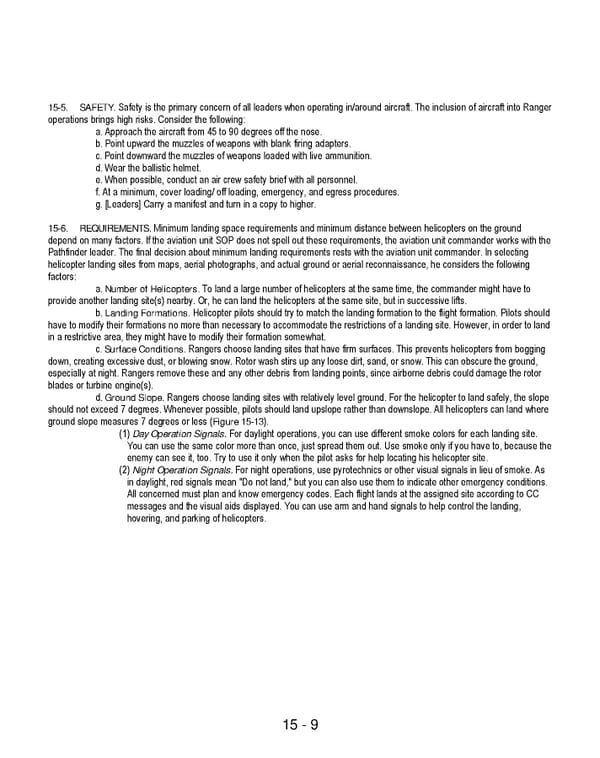15 - 9 15-5. SAFETY. Safety is the primary concern of all leaders when operating in/around aircraft. The inclusion of aircraft into Ranger operations brings high risks. Consider the following: a. Approach the aircraft from 45 to 90 degrees off the nose. b. Point upward the muzzles of weapons with blank firing adapters. c. Point downward the muzzles of weapons loaded with live ammunition. d. Wear the ballistic helmet. e. When possible, conduct an air crew safety brief with all personnel. f. At a minimum, cover loading/ off loading, emergency, and egress procedures. g. [Leaders] Carry a manifest and turn in a copy to higher. 15-6. REQUIREMENTS. Minimum landing space requirements and minimum distance between helicopters on the ground depend on many factors. If the aviation unit SOP does not spell out these requirements, the aviation unit commander works with the Pathfinder leader. The final decision about minimum landing requirements rests with the aviation unit commander. In selecting helicopter landing sites from maps, aerial photographs, and actual ground or aerial reconnaissance, he considers the following factors: a. Number of Helicopters. To land a large number of helicopters at the same time, the commander might have to provide another landing site(s) nearby. Or, he can land the helicopters at the same site, but in successive lifts. b. Landing Formations. Helicopter pilots should try to match the landing formation to the flight formation. Pilots should have to modify their formations no more than necessary to accommodate the restrictions of a landing site. However, in order to land in a restrictive area, they might have to modify their formation somewhat. c. Surface Conditions. Rangers choose landing sites that have firm surfaces. This prevents helicopters from bogging down, creating excessive dust, or blowing snow. Rotor wash stirs up any loose dirt, sand, or snow. This can obscure the ground, especially at night. Rangers remove these and any other debris from landing points, since airborne debris could damage the rotor blades or turbine engine(s). d. Ground Slope. Rangers choose landing sites with relatively level ground. For the helicopter to land safely, the slope should not exceed 7 degrees. Whenever possible, pilots should land upslope rather than downslope. All helicopters can land where ground slope measures 7 degrees or less (Figure 15-13). (1) Day Operation Signals. For daylight operations, you can use different smoke colors for each landing site. You can use the same color more than once, just spread them out. Use smoke only if you have to, because the enemy can see it, too. Try to use it only when the pilot asks for help locating his helicopter site. (2) Night Operation Signals. For night operations, use pyrotechnics or other visual signals in lieu of smoke. As in daylight, red signals mean "Do not land," but you can also use them to indicate other emergency conditions. All concerned must plan and know emergency codes. Each flight lands at the assigned site according to CC messages and the visual aids displayed. You can use arm and hand signals to help control the landing, hovering, and parking of helicopters.
 Ranger Handbook Page 282 Page 284
Ranger Handbook Page 282 Page 284